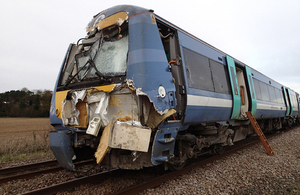Report 04/2017: Collision at Hockham Road user worked crossing, Thetford
RAIB has today released its report into a collision between a train and tractor at Hockham Road user worked crossing, Thetford, 10 April 2016.

Image showing damage to train 1K77
Summary
At 12:30 hrs on 10 April 2016 a passenger train travelling from Norwich to Cambridge collided with an agricultural tractor and trailer on a level crossing at Hockham Road, near Thetford in Norfolk. The train was travelling at 87 mph (140 km/h) when, on the approach to the crossing, the train driver saw a tractor moving closer to the railway tracks. The train driver sounded the train’s horn and applied the emergency brake, but could not stop before colliding with the tractor. The train did not derail, but its driving cab was damaged, and the driver and four passengers suffered minor injuries. The tractor was destroyed, and its driver was seriously injured.
The level crossing at Hockham Road is on a restricted byway, and has gates which are operated by crossing users. About one minute before the collision, the tractor driver had obtained permission to cross from a signaller at the Network Rail signal box at Cambridge. The signaller had given him permission to cross when there was insufficient time before the train would arrive at the crossing. This was because the signaller had lost his awareness of the position of the train because his levels of concentration may have lapsed, and his competence to operate the workstation safely and effectively had not been adequately monitored.
A system that had been installed at the level crossing in 2012, intended to display green or red lights to crossing users to warn them whether or not it was safe to cross, was not working at the time of the accident. It had been decommissioned by Network Rail following concerns which the company had about the safety integrity of the system. This had meant that users had to telephone the signaller for permission to cross. The RAIB found that Network Rail had not come to a clear understanding with the manufacturer of the system about how the equipment met the required safety integrity level, and having assessed the risks, had decided to turn off the system while improvements were made.
An underlying factor was that the arrangements in Cambridge signal box for managing fatigue among signalling staff were inadequate.
Recommendations
The RAIB has made three recommendations to Network Rail. The first concerns Network Rail’s approach to managing user worked level crossings, with the intention of either eliminating the need for a signaller to have to decide whether it is safe for a user to cross the railway or providing better information for signallers when making these decisions. The second relates to the processes that Network Rail uses when introducing new signalling equipment whose operating interface differs significantly from existing equipment, and the third covers the management of the competence of signalling shift managers when they also operate signalling equipment.
Simon French, Chief Inspector of Rail Accidents said:
In recent years, the RAIB has become concerned about signaller error as a cause of accidents at level crossings where it is always necessary for vehicle drivers to telephone the signaller for permission to cross (ie user worked crossings with telephones). In addition to our investigation of the collision between a train and tractor at Hockham Road, 2016 saw the opening of two other investigations into dangerous occurrences of this type. In both cases people were given permission to cross the railway with vehicles when trains were too close for this to be done safely.
Communicating with level crossing users will be one of many duties carried out by a signaller. In an environment where signalling control areas are becoming larger, and the number of crossings overseen by an individual signaller may often increase, it is important that the railway industry considers carefully the measures required to control the risk of signaller error leading to collision. Giving permission for users to cross the railway will often require signallers to carefully check the location of trains and estimate the time available for users to cross in safety. Although the reliability of such decisions is likely to be improved if signallers are provided with better information, it would be preferable to see, over the longer term, the progressive removal of crossings where the only form of protection is the telephone.
We are recommending that Network Rail should undertake a review of its measures for the protection of such crossings with the objective of reducing the risk of signaller error.
Notes to editors
- The sole purpose of RAIB investigations is to prevent future accidents and incidents and improve railway safety. RAIB does not establish blame, liability or carry out prosecutions.
- RAIB operates, as far as possible, in an open and transparent manner. While our investigations are completely independent of the railway industry, we do maintain close liaison with railway companies and if we discover matters that may affect the safety of the railway, we make sure that information about them is circulated to the right people as soon as possible, and certainly long before publication of our final report.
- For media enquiries, please call 01932 440015.